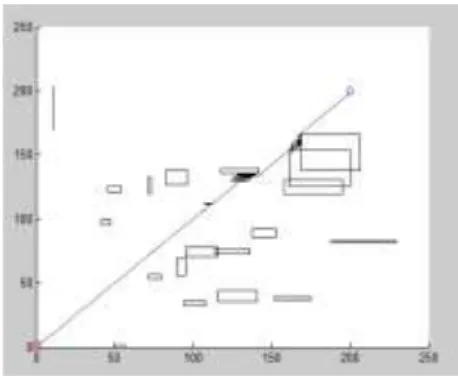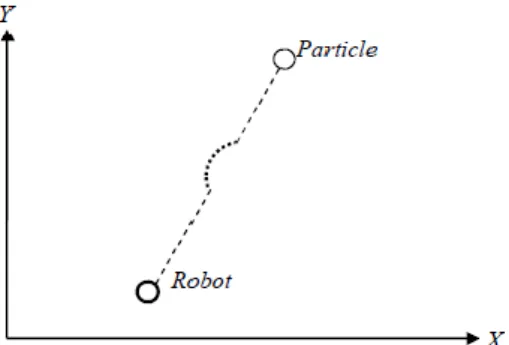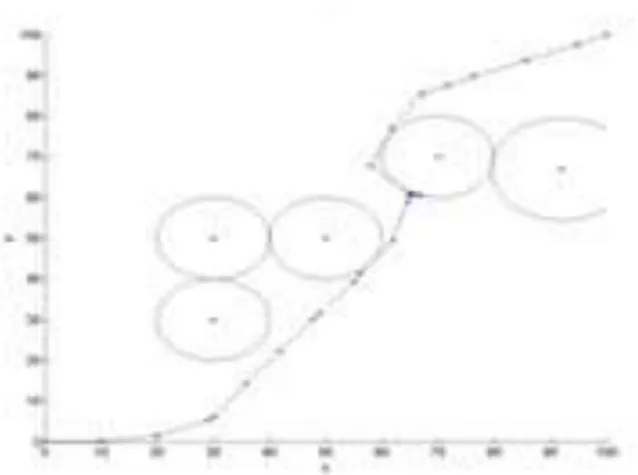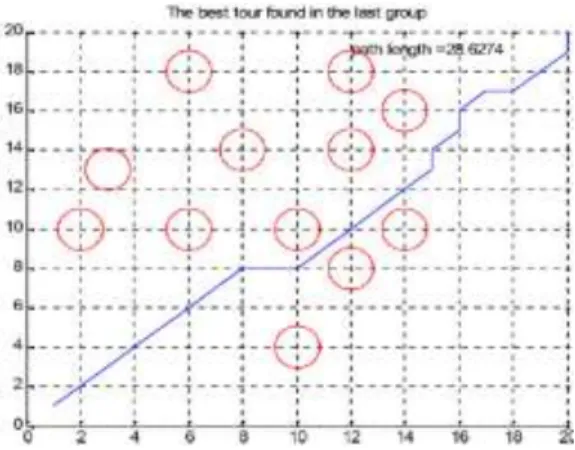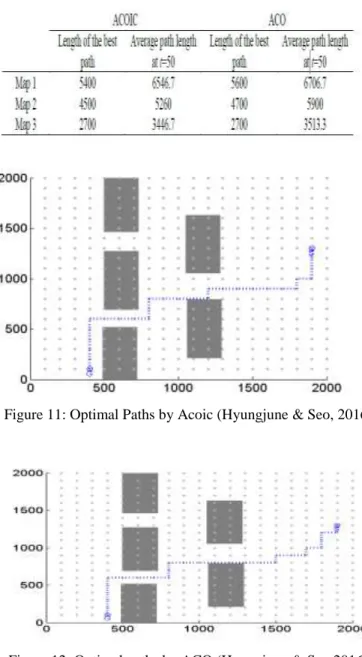Covenant Journal of Informatics & Communication Technology. Vol. 6 No. 1, June, 2018
An Open Access Journal Available Online
Mobile Robot Path Finding using Nature Inspired
Algorithms - A Review
Chika Yinka-Banjo
1& Ukamaka Agwogie
21,2 Department of Computer Science, Lagos, Nigeria
cyinkabanjo@unilag.edu.ng amymathematics@gmail.com
Abstract — In today’s world, Mobile Robot has been widely used for various purposes across several aspects of life. The environments could be static and dynamic. Path planning for mobile robot is a very important problem in robotics. Path Planning for robot could be referred to the determination of a path; a robot takes in to perform a task given a set of key inputs. To find the best and optimal path from the starting point to the goal point, such that time and distance is reduce, in any given environment avoiding collision with obstacles is an interesting area for research. This research presents a review on the application of nature inspired algorithms in solving the problem of mobile robot path planning such that the robot reaches the target station from source station without collision with obstacles. The future of these nature-inspired algorithms on mobile robot is also discussed.
Keywords: Index Terms — Nature-Inspired Algorithms, Optimization, Path Planning
1. Introduction
The field robot path planning started in the middle of the 1960’s. Path planning is an important part in the design of mobile robots. The objective is to find the best and collision free path from a start position to a target position in a given environment. Path planning would
aid robot to automatically decide and execute a sequence of steps in order to accomplish a task without colliding with obstacles in a given environment
(Parvez & Dhar,2013). In an
environment, there are many paths for a robot to reach the goal, but the best path is selected according to some criteria.
These criteria are the shortest distance, the shortest time, the least energy consumed. The most adopted criteria are the shortest distance. Path planning is an optimization problem since its purpose is to find a path with the shortest distance under certain constraints such as the given environment with collision- free motion ( Agarwal & Goel, 2013). In the past several decades, research on optimization techniques has captured the
attention of most researchers.
Optimization techniques can be
classified in many ways; however, the simplest way is to look at the nature of the algorithm. In this light, they can be grouped into two: deterministic and stochastic techniques (Chen et al ,2011). Deterministic techniques depend on the mathematical nature of the problem, while stochastic methods do not depend on the mathematical nature of the problem. Stochastic techniques use randomization in its techniques to arrive at a solution. They are more appropriate for finding the global optimal solutions for any type of objective function.
However, the weakness of the
deterministic techniques is its
dependence on gradient. Local optima and inefficient in large scale search
space and cannot solve discrete
functions. Stochastic techniques are more user friendly. The complexity of today’s real-world optimization problem has made the use of stochastic techniques inevitable. These algorithms have been discovered to perform better than the classical or gradient based methods, especially in optimizing discrete complex, multimodal and non-differentiable functions (Chen et al ,2011). Nature Inspired algorithms are stochastic techniques that mimic the behaviors of human evolution, certain animals or insects. They have been
developed since 1980s. Today, these nature inspired algorithms have already been applied to many areas in engineering fields.
Currently, the existing research in the path finding problem in robotics can be classified in two aspects: classical and heuristic. The most famous classic methods of path planning are potential field methods, grid methods and visibility graph methods. The potential
field methods have very simple
structures and are used in real time hurdle avoidance. However, there are inbuilt limitations in them; these includes trap conditions due to local minima, no passage between closely spaced objects or obstacles, oscillations in the presence of obstacles and oscillations in narrow paths. In the grid methods where grids are used to form the map of the environment, the size of
the grids and the environment
representation are directly proportional. The main problem of visibility graph methods is that they have very intricate search paths and very less search efficiency (Nizar & Farah,2014).
To overcome the limitations of classic methods to path planning; researchers have over time move towards heuristics methods. There is an increase in the development on heuristics methods over the past two decades. Heuristics methods has helped to deal with the complexities and computational costs associated with classical methods. However, one is not sure to come across a solution while using the heuristics methods, but if there is a solution it will be found much faster than the classical methods. The following heuristics approaches have been applied to the path planning problem in mobile robot. They are Genetic Algorithm (GA), Particle Swarm Optimization (PSO),
Chika Yinka-Banjo & Ukamaka Agwogie CJICT (2018) 6(1) 57-73
Ant Colony Optimization (ACO), Bee Colony Optimization (BCO) etc.
In this research, the application of nature-inspired heuristics algorithms in
solving path finding problem in
Robotics is reviewed also the expected future of the path finding problem in Robotics using nature-based heuristics algorithms would be discussed. The work is organized as follows: Section 2 deals with path planning optimization techniques, introduced nature-inspired algorithms, and described how some nature inspired algorithms have been applied to the path planning problem, Section 3 gives a summary of the application discussed in section 2, Section 4 gives the expected future trend and Section 5 provides the conclusion.
2.Mobile Robot Path Planning Optimization
Path finding is a fundamental aspect of many applications in the fields of GPS, games, robotics, logistics and crowd simulation (Zeyad et al ,2015). It can be implemented in static, dynamic and
real-time environments. Several
developments have carried out to improve the accuracy and efficiency of the path finding solutions over the past two decades. However, the problem still attracts a great deal of research. Today, the most important area of concerns is the provision of high performance, realistic paths for users (Zeyad et al ,2015).
In general, there are various kinds of path finding problem, such as single agent, multi-agent, adversarial. Some problems could be in the dynamic environment, heterogeneous terrain,
mobile units and incomplete
information. Each of these problems has different applications in different fields. Solving path finding problems consists of two main steps: graph generation and
a path finding algorithm (Zeyad et al ,2015). Several techniques have been used to solve the graph generation problem; such as cell decomposition and Skeletonization.
The second step in the path finding process is the search algorithm itself. The objective of the algorithm is to return the optimal path to users in an efficient manner. These algorithms can be broadly classified as discrete path planning algorithms and Nature-inspired algorithms. Discrete path planning algorithms, such as potential fields, splines, grid based and tangent finding have been found to have high processing and large memory for computation. However, the nature inspired algorithms have been seen to provide possible solution to the limitations of these
discrete techniques. Heuristics
algorithms are able to cover a large search space and use a relatively low amount of memory and CPU resources.
2.1 Nature Inspired Algorithms (NIAs)
Nature-inspired algorithms are also referred to as evolutionary algorithms (EAs) (Emad et al ,2005). The limitations associated with using classical optimization techniques on large scale engineering problems have led to the development of alternative solutions. Nature-inspired algorithms are stochastic search methods that
mimic the behaviour of natural
biological evolution and/or the social behaviour of species. The behaviour of these species is guided by learning, adaptation and evolution. To imitate the efficient behaviour of these species, several researchers have developed computational systems that seek fast and
robust solutions to complex
Some of the Nature inspired heuristics algorithms are:
• Genetic Algorithms (Inspired by evolution)
• Memetic algorithms (Inspired by evolution)
• Particle swarm optimization
(Inspired by social foraging
behaviour of some animals)
• Ant colony systems (Inspired by the foraging behaviour of ants)
• Bee colony system (Inspired by the foraging behaviour of honey bees) • Fruit fly algorithm (Inspired by the
food finding behaviour of fruit flies) • Firefly algorithm (Inspired by the
flashing behaviour of fireflies) • Bat algorithm (Inspired by the
echolocation behaviour of micro bats)
• Simulated annealing (Inspired by
the process of annealing in
metallurgy)
• Neural Networks (Inspired by the neurons in the human brain) etc. However, in this study we will look at the application of four of these nature-based heuristics algorithms to the mobile robot path finding problem. They are Genetic Algorithm, Particle
swarm optimization, Ant colony
systems and Bee colony system.
Genetic Algorithms are search and optimization techniques first proposed by John Holland in the early 1970s (McCall ,2005). It is based on the principles of natural evolution. GA has been recognized as one the most robust search methods for complex and ill-behaved optimization problems. In Genetic Algorithm, a solution to a given problem is given in the form of chromosome, a chromosome consists of a set of elements, called ‘genes’ that hold a set of values for the optimization variables.
Particle Swarm optimization is a global
optimization method proposed by
Kennedy and Eberhart in 1995 (Bai, 2010). PSO is a stochastic optimization technique which is also population based like Genetic Algorithm. PSO is inspired by the social foraging of bird
flocking together. PSO uses the
information sharing mechanism. The population grows from experience learnt from each other.
Ant colony optimization is a
meta-heuristic stochastic optimization
technique developed by Marco Dorigo in 1992. ACO is inspired from the ants foraging behaviour. The behaviour in particular is how ants can find the shortest paths between their nest and its food sources. Ants deposit pheromone as they move around in search for food.
These pheromone serves as a
communication information to other ants. It is used to mark the way taken to a destination. Ants can also find the optimum path quickly when an obstacle suddenly appears in their way as they search for food.
The Artificial Bee Colony (ABC) optimization technique is also a
population based meta-heuristics
algorithms. It is inspired by the intelligent behaviour of real honey bees (Mohd et al ,2015). The algorithm was first proposed by D. Karaboga in 2005
for real parameter optimization
problems (Nizar & Farah,2014). The ABC algorithm employs fewer control parameters in its implementation, these characteristics gives it an advantage over other population based algorithms. ABC algorithm has been applied to solve many practical optimization problems because of its flexible, simple and easy to implement.
Chika Yinka-Banjo & Ukamaka Agwogie CJICT (2018) 6(1) 57-73 2.2 Robotic Path Planning Using
Nature Inspired Algorithms
2.2.1 Robotic Path Planning using
Genetic Algorithm in Dynamic
Environment (Arora et al ,2014)
The researchers apply Genetic
Algorithm at a point in the problem
space unlike the other existing
approaches where GA has been applied to the whole problem space. The simulation system was dynamic and it was carried out in a 2-D space. The approach uses 20 randomly generated rectangular obstacles with variable sizes which positions is not known to the root prior to its movement (dynamic system) as shown in Figure 1. The authors allow
the robot to begin its movement towards the destination using a diagonal path. On an encounter with an obstacle the robot takes three steps backward and applies Genetic Algorithm to determine the next path as seen in Figure 2. This
approach was simulated using
MATLAB. CPU utilization was
obtained for four iterations as seen in Table 1. However, there was no explicit comparison of this approach to other known results to ascertain the optimality of the approach. The author, however concluded that the approach led to the shortest minimum path or the robot as seen in Figure 4
Figure 1: Problem Configuration (Arora et al ,2014)
Figure 3: Solution Obtained (Arora et al ,2014)
Table I: Number of Iterations Vs CPU Time in Seconds (Arora et al ,2014).
No. of iterations CPU Time (sec).
10 26
20 102
30 122
40 139
2.2.2 A Mobile Robot Path Planning Using Genetic Algorithm in Static Environment (AL-Taharwa et al ,2008)
This study shows the implementation of
Genetic Algorithm in a static
environment, this means the
environment has been predefined and the position of obstacles are known to the navigating robot prior to its movement. A simplified fitness function
was used; it uses the path length to determine the best individual in a generation. Simulations were done in obstacle free environment and three obstacle full environment. It was discovered that Genetic Algorithm converges irrespective of the population size used. However, increasing the
population size increases the
computational cost. Table 2, 3, 4 gives a tabular display of the results obtained.
Table II: GA Performance with Population Size 10 (Al-Taharwa et al ,2008).
Environment Population size Best fitness value Generation No. Obstacle-free environment 10 20 60
Indoor Environment 10 38 100
Moderate environment 10 26 90
Complex environment 10 26 80
Chika Yinka-Banjo & Ukamaka Agwogie CJICT (2018) 6(1) 57-73
Table III: GA Performance with Population Size 20 (AL-Taharwa et al ,2008)
Environment Population size Best fitness value Generation No.
Obstacle-free environment 20 18 60
Indoor Environment 20 32 100
Moderate environment 20 22 90
Complex environment 20 26 30
Table IV: GA Performance with Population size 50 AL Paths by ACO (AL-Taharwa et al ,2008).
Environment Population size Best fitness value Generation No.
Obstacle-free environment 50 18 60
Indoor Environment 50 28 100
Moderate environment 50 20 90
Complex environment 50 24 80
2.2.3 Using Particle Swarm Optimization for Robot Path Planning in Dynamic Environments with Moving Obstacles and Target. (Yarmohamadi et al ,2011)
The study uses the particle swarm optimization techniques in a dynamic environment where the position of the target moves over time. Moving and static obstacles were also present in the system. In order to simulate the proposed approach; assumptions were made. Some of them are that the robot (Vrobot) and target (Vgoal) have maximum footsteps for which they must not exceed and there is also a relocation probability associated to the moving obstacles (Pobs) and the target (Pgoal). Circular shaped obstacles were used and the root moves in a rotational manner, it also investigates its surroundings using
a radius from itself in order to find the next position with minimum collisions. A penalty function was introduced to solve the local optimum problem of PSO. This function uses the size and position of the obstacles to determine the next position. Simulations were carried out using MATLAB and it was successful. Figure 4 shows two possible routes the robot could take if an obstacle is encountered; however using the penalty function; the path with the shorter length will be selected. Figure 5 shows the result of the simulations when the relocation probability of the target and moving obstacles are set to 0. Figure 6 shows when the parameters were varied. Again, the performance of the novel approach was not compared to the existing approaches existing in the field.
(b)
Figure 4: (a) and (b) are two possible routes the Robot can take. using the Penalty Function the Route (a) Will be Selected (Yarmohamadi et al ,2011).
Figure 5. For the Robot, VROBOT =10. For every obstacle, POBS=0. For the goal, PGOAL=0 (Yarmohamadi et al ,2011).
Figure 6. For the robot, VROBOT=30. For the obstacles, VOBS=5; P1obs =0.4 and P2obs=0.7. For the goal, pgoal=0.3 and VGOAL=10 (Yarmohamadi et al ,2011).
2.2.4 Improvement of Robot Path
Planning Using Particle warm
Optimization in Dynamic
Environments with Mobile Obstacles
and Target (Nasrollahy &
Javadi,2009).
The researchers here improved the penalty function used in (Yarmohamadi et al ,2011). The penalty function was based on the state of the environment. A penalty value is assumed for every obstacle and the influence of the
adjacent obstacles are added to the length of the arc for that portion. Simulations were done using MATLAB with four different environmental set up. Table 5 gives the details of the environment. It was concluded that the improved penalty function achieved a better result compared with the results of previous work. Figures 7 and 8 were captured during the simulations with varied parameters.
Table V: Details Of The Four Simulation Environments (Nasrollahy & Javadi,2009).
Figure No of Obs No of SObs No of DObs Pgoa l Vgo al Vrob s 7 5 5 0 0 0 10 8 8 8 0 0.3 5 30
Figure 8: Path Displayed with Robot Velocity = 30 (Nasrollahy & Javadi,2009).
2.2.5 Mobile Robot Path Planning
Using Ant Colony Optimization
(Mohanraj et al ,2014)
A grid based environment represented in a grid model was used to simulate the path planning of mobile robot. The researcher represents the robot as a point in the grid to reduce computational complexities. A heuristics factor was
added to the simple ant colony optimization algorithm. Simulations were done using MATLAB and it was clear that the ACO-MH outperform the SACO. Table 6 shows the parameter specification used for ACO and ACO-MH. Figure 9 and 10 show the map taken by the robot during simulation.
Table VI: Parameter Specification for ACO and ACO-MH Algorithms (Mohanraj et al ,2014).
Parameters SACO ACO-MH
No. of Ants (m) 10 10
Weight value (α) 0.25 0.25
Heuristic Factor (β) 0 1
Radius of the obstacles 1 1
pheromone evaporation rate (ρ) 0.1 0.1
Figure 9: Optimal Path using ACO Algorithm (Mohanraj et al ,2014).
Chika Yinka-Banjo & Ukamaka Agwogie CJICT (2018) 6(1) 57-73
Figure 10: Optimal path found using ACO-MH Algorithm (Mohanraj et al ,2014).
Table VII: Comparison of results for ACO and ACO-MH Algorithms (Mohanraj et al ,2014).
Ex No SACO (ACS) ACO -MH
Distance (cm) Time (sec) Distance (cm) Time (sec)
1 31.799 3.669818 28.6274 3.26651
2 33.8995 6.5687 32.1421 6.903165
3 32.7279 2.398471 32.1421 2.369687
2.2.6 Path Planning For a Mobile
Robot Using Ant Colony
Optimization and the Influence of Critical Obstacle (Hyungjune & Seo,2016).
The ant colony optimization was applied to the path finding problem using inference of critical obstacle. The proposed methodology uses the values propagated by the critical obstacles as the initial pheromone and initial transition probabilities. This approach enhances the standard ACO algorithm by directing ants towards the preferable
direction rather than allowing them to wander all directions in the same weight. This will enable the ants to reach the target efficiently without considering all regions since the optimal path can be obtained around the critical obstacles. Simulations was carried out in
three maps with different
configurations. In all the maps, the critical and non-critical obstacles were
assigned different values. The
performance was compared with the standard ACO algorithm. It was seen that ACOIC out performed ACO.
Table VIII: Result of Path Length (CM) Obtained using Acoic and Aco (Hyungjune & Seo, 2016).
Figure 11: Optimal Paths by Acoic (Hyungjune & Seo, 2016).
Figure 12: Optimal paths by ACO (Hyungjune & Seo,2016).
2.2.7 Path Planning of Mobile Robots Using Artificial Bee Colony
Algorithm ( Agarwal & Goel, 2013).
In this work, the researcher applied the artificial bee colony algorithm to find the optimized path for the robot. Two steps were used in the by them; first was to create an initial collision free path from the start point to the goal point and
the second was to use the ABC algorithm to find optimal initial path. The proposed algorithm considers that every path consists of straight line segments passing through or from specific points. These points will be selected according to the fitness values to produce a path with shorter lengths. The ABC algorithm5 was used to find
Chika Yinka-Banjo & Ukamaka Agwogie CJICT (2018) 6(1) 57-73
this optimal path. The simulation was performed on the grid environment. The population size and number of iterations was kept at 100 and 50 respectively for
both environments. The result obtained shows that the ABC algorithm was able to find an optimized path from the start point to the goal point.
Figure 13: Simulation result in densely occupied environment ( Agarwal & Goel, 2013).
3. Application of the Nature Inspired Algorithms to Mobile Robot Path finding Problem.
Nature inspired algorithms have been applied to the mobile robot problem by several researchers. These algorithms have been applied to both the static and
dynamic environment. Static
environment is when the robot is aware of the obstacles positions in the map and the position of the obstacles do not change with time while in dynamic environment; these obstacles appears unpredictably in course of motion and the position of the obstacles changes with time. In case of robot navigation, a
mobile robot reaches the target
destination from source station,
avoiding collision with obstacles and upon iterations gives an optimal path
without any human involvement
(Mohanraj et al ,2014).
Genetic Algorithm was applied by (Yarmohamadi et al ,2011) to solve the mobile robot path finding problem in a dynamic environment. They tested the approach using 20 randomly generated obstacles. The location of the obstacles is not known to the robot; hence it is dynamic. Out of the many paths
generated; the one with the minimum distance is from start to goal node was selected as the optimal path.
In (AL-Taharwa et al ,2008) Genetic Algorithm was applied in a static environment where the positions of the obstacles were known to the robot prior its movement. A simplified fitness function was used; it uses the path length to determine the best individual in a generation. It was discovered that
Genetic Algorithm converges
irrespective of the population size used. Modified Particle Swarm Optimization was applied to the path finding problem of mobile robot by ((Yarmohamadi et al ,2011). A penalty function was proposed as a constraint optimization to enable the robot finds the shortest path to the destination by observing the size and position of the obstacle which has blocked its trajectory. This approach allows the process not to be trap in local optimum and ensures a path is found always if it exist.
The penalty function introduced in (Arora et al ,2014) was improved upon by (Nasrollahy & Javadi,2009). Every obstacle was given an assume penalty
value and the influence of the adjacent obstacles were added to the length of the arc. It was concluded that the improved penalty function achieved a better result compared with the results of previous work.
Ant Colony Optimization algorithm was modified using the inference of critical obstacles to guide the robots in order to find the shortest path to the goal. This approach was proposed by (Hyungjune & Seo,2016). The ACOIC methodology was implemented in several maps in order to find a feasible and shortest path. The results were compared to the standard ACO algorithm. It was seen that ACOIC outperformed the ACO; that is utilizing the initial pheromones to lead ants to the critical obstacles is more effective in quickly finding an optimal path than in applying the constant initial pheromones as done in ACO.
Artificial bee colony was applied by ( Agarwal & Goel, 2013) to the problem by using two steps: first was to create an initial collision free path from the start point to the goal point and the second was to use the ABC algorithm to find optimal initial path. The proposed algorithm considers that every path consists of straight line segments passing through or from specific points. These points will be selected according to the fitness values to produce a path
with shorter lengths. The ABC
algorithm was used to find this optimal path.
Table 9 shows some of the
characteristics of the nature inspired algorithms x-rayed. Artificial Bee Colony Optimization algorithm can be concluded due to the few number of parameters that can be tweaked, the implementation is easier compared to Genetic Algorithm whose number of parameters is as high as 5.
Table IX: Some Characteristics of the Nature Inspired Algorithms. Nature Inspired Algorithms Genetic Algorithm Particle Swarm Optimization Ant Colony Optimization Artificial Bee Colony No. of Parameters 5 4 4 2 Large Scale Problems
Yes Yes Yes Yes
Computational time
High Low Low Low
Concept Clarity Complex Complex Complex Easy Feedback
Mechanism
No Yes Yes Yes
Implementation Complex Easy Complex Easy
4. Future Trend
The review shows that there is still scope for developing more efficient on-line path planning algorithms (Tang et al ,2015) with moving obstacles that will produce better quality routes by
addressing real-time recognition of the moving obstacles and producing the shortest and safe path dynamically. With the prediction of the future of robotics being the drive for innovation to give company the competitive edge.
Chika Yinka-Banjo & Ukamaka Agwogie CJICT (2018) 6(1) 57-73
Robot should be able to move from
point to point without human
intervention and smoothly by avoiding collision with obstacles and human in its
work space. Introduction of
sophisticated sensors and camera in the robot space will aid a smooth path generation by the robot to enable it to achieve the goal with the shortest possible time.
As we know, organisms do not have sensors, but they are able to achieve perfect sense function. In the future nature inspired sensors and cognitive model should be developed in order to improve the precision of the sensors and to reduce the high production cost incurred with the development of high precision sensors. The cognitive model of organisms can also be applied to the mechanism of robots. The performance of these nature inspired algorithms in real applications of mobile robot is also a concern to be addressed in the future. This will lead to the development of robot with high intelligence, self-learning, and self-perception in the mobile robot field. . In the future we hope to see where robots can move in a dynamic environment powered by a more efficient hybridize algorithm, nature inspired sensors and mechanisms.
5. Conclusion
In this work, we have reviewed the application of nature inspired algorithms
to the problem of path finding in mobile robot. We can see that several approaches have been used to solve this problem both in static and dynamic environment.
It is clear that nature inspired algorithms is an expandable field with innovative ideas and thoughts. It is also one of the
hottest research points in the
computation world today and will play an important role in mobile robot control, which will be a good solution to improve the intelligence and autonomy of mobile robot.
Currently, ways of solving the path finding problem in mobile robot based on these algorithms have been explored and the results are exciting to demonstrate the potential of NIAs. However, most of the results available are only conducted by simulation; additional efforts are needed to develop some more efficient NIAs and transit these results to real applications in mobile robot control.
Acknowledgment
The authors gratefully acknowledge the financial support of African Institute for mathematical sciences (AIMS) Alumni small research grant (AASRG) ,the Organisation for Women in Science for the Developing World (OWSD), and L’oreal-Unesco for Women in Science.
References
Mansi Agarwal, Priyanka Goel, (2013). Path Planning of Mobile Robots using Bee Colony Algorithm. MIT
International Journal of Computer
Science & Information
Technology, Vol. 3, No. 2, August 2013, pp. 86–89 ISSN 2230-7621
Nizar Hadi Abbas, Farah Mahdi Ali, (2014). Path Planning of an Autonomous Mobile Robot Using Directed Artificial Bee
Colony Algorithm. International
Journal of Computer
Applications (0975 – 8887) Volume 96– No. 11.
Zeyad Abd Algfoor, Mohd Shahrizal Sunar, and Hoshang Kolivand, (2015). A Comprehensive Study on Pathfinding Techniques for Robotics and Video Games.
International Journal of
Computer Games Technology Volume 2015 (2015), Article ID 736138, 11 pages
Emad Elbeltagia, Tarek Hegazy, Donald Grierson, (2005). Comparison among five Evolutionary-based
Optimization algorithms.
Advanced Engineering
Informatics 19 (2005) 43–53
John McCall, (2005). Genetic
Algorithms for modelling and
optimization. Journal of
Computational and Applied
Mathematics 184 (2005) 205– 222.
Ismail AL-Taharwa, Alaa Sheta and Mohammed Al-Weshah, (2008). A Mobile Robot Path Planning Using Genetic Algorithm in Static Environment. Journal of Computer Science 4 (4): 341-344, 2008ISSN 1549-3636. Er.Waghoo Parvez, Er. Sonal Dhar,
(2013). Path Planning
Optimization Using Genetic
Algorithm – A Literature
Review. International Journal of
Computational Engineering
Research||Vol, 03||Issue, 4||. Qinghai Bai, (2010). Analysis of
Particle Swarm Optimization
Algorithm. Computer and
Information Science Vol.3, No. 1 T. Mohanraj, S. Arunkumar, M. Raghunath, M. Anand, (2014). Mobile Robot Path Planning Using Ant Colony Optimization. International Journal of Research in Engineering and Technology eISSN: 2319-1163 | pISSN: 2321-73088.
Toolika Arora, Yogita Gigras, Vijay Arora, (2014). Robotic Path
Planning using Genetic
Algorithm in Dynamic Environment. International Journal of Computer Applications (0975 – 8887) Volume 89 – No 11, March 2014.
Amin Zargar Nasrollahy, Hamid Haj Seyyed Javadi, (2009). Using Particle Swarm Optimization for Robot Path Planning in Dynamic
Environments with Moving
Obstacles and Target. Third UKSim European Symposium on
Computer Modeling and
Simulation.
Jihee Han, Hyungjune Park and Yoonho Seo, (2016). Path planning for a mobile robot using Ant colony Optimization and the influence of critical obstacle. Proceedings
of the 2016 International
Conference on Industrial
Engineering and Operations
Management Detroit, Michigan, USA, September 23-25, 2016. Hanning Chen, Yunlong Zhu and
Kunyuan Hu, (2011). Adaptive Bacterial Foraging Optimization. Hindawi Publishing Corporation, Abstract and Applied Analysis, Volume 2011.
Zeyad Abd Algofoor, Mohd Shahrizal1
Sunar and Hoshang
Kolivand,(2015). A
Comprehensive Study on
Pathfinding Techniques for
Robotics and Video Games.
International Journal of
Computer Games Technology. Volume 2015.
Mohd Nadhir Ab Wahab, Samia Nefti-Meziani and Adham Atyabi,
(2015). A Comprehensive
Review of
Chika Yinka-Banjo & Ukamaka Agwogie CJICT (2018) 6(1) 57-73
Swarm Optimization Algorithms. PLoS ONE 10(5): e0122827.1
S.H.1 Tang, Farah Kamil, W. Khasksar, N. Zulkifli, S.A Ahmad, (2015). Robotic motion planning in
Unknown dynamic
environments: Existing
approaches and challenges. 2015 IEEE International Symposium
on Robotics and Intelligent Sensors (IRIS), 2015.
Maryam Yarmohamadi , H. Haj Seyyed Javadi , Hossein Erfani, (2011). Improvement of Robot Path Planning Using Particle Swarm
Optimization in Dynamic
Environments with Mobile
Obstacles and Target
